Robert Teo from the National Parks Board (NParks) shared this video showing a wild Malayan porcupine (Hystrix brachyura) being released, after it had been caught and kept as a pet by one of the villagers.
Robert shared more background information:
During our regular Forest Patrol on 30 Mar 2012, my staff and volunteers found a Malayan Porcupine (Hystrix brachyura) caged in a resident’s home. It measured about 60-70 cm from nose to base of tail and appeared to be a female. The porcupine entered the resident’s compound in late Jan 2012 and was cornered by her dogs. It was subsequently netted and a cage was constructed to house it. The resident fed it with apples, carrots & kangkong.
The resident was reluctant to let it go as she thought it would not be able to survive on its own. She even asked that we send it to the zoo. We explained that the porcupine is a wild animal and would be able to fend for itself, and that the right thing to do was to return it to the wild. She requested to keep it over the weekend to show her relatives. On the morning of 2 Apr, we transported the cage to the forest nearby and released the porcupine."
Robert also uploaded several shorter video clips of the porcupine.
This find is particularly notable because there haven't been any recent records of Malayan porcupines on Pulau Ubin.
Among the many mammal specimens in the Public Gallery of the Raffles Museum of Biodiversity Research is the skin of a Malayan porcupine, which was collected at Bukit Timah in 1923.

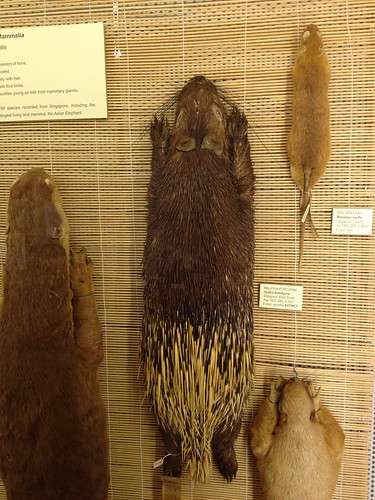
For many years, due to a lack of sightings, it was believed that the Malayan porcupine had been wiped out in Singapore. A 1990 review on the wild mammals of Singapore mentioned that while the species was once common in forested areas between 19th century to the 1960's, and was still said to be "sometimes found in secondary forests" in 1973, the review said that it "must be very rare if it still exists in Singapore".
However, in December 2005, camera traps set up for Norman Lim's study of Sunda pangolins (Manis javanica) captured images of several other mammal species on Pulau Tekong, among them a Malayan porcupine. As he recounts on Habitatnews:
Yeo Suay Hwee and I heard rasping sounds in the vegetation near base camp. My torch beam picked up an eye-shine and I saw what appeared to be a huge rodent rocking to and fro. The bush was in the way but I managed to see short spines behind the head! The creature which was scratching its claws against a concrete kerb, seemed oblivious to my presence. Whistling to Suay Hwee to come over frightened the animal as it vanished into the bush.Here are some camera trap photos showing the porcupine foraging on the night of 16th December 2005, between 9.35 and 10 pm:
I was sure it was a porcupine but that brief, partially concealed encounter, left me in doubt about the species identity. So an infrared-triggered camera-trap was set up at the same place the following evening, and I sweetened the deal with some sweet potatoes and tapioca bait.
A week later however, the camera recorded images of wild boar, plantain squirrel, emerald dove, rats and even a juvenile pangolin, all quite enjoyable scenes, but no porcupine. Just a week after that, however, the porcupine photographed taking the bait on two occasions - on 16 Dec 2005: 9:30 pm and 18 Dec 2005: 10.00pm!
The animal (believed to be a single individual) is estimated to be between 70 - 80 cm in total length. It has a a short tail and prominent black and white markings. We identified this animal as a Malayan Porcupine (Hystrix brachyura). There are no previous records of porcupines on Pulau Tekong. Even the military personnel stationed on the island reported pangolins, slow lorises and leopard cats, but not porcupines.




Last year, it was revealed that a camera trap set up in Bukit Timah Nature Reserve as part of a survey to study the animals that might benefit from the upcoming Eco-Link@BKE had recorded a Malayan porcupine. So not only are there Malayan porcupines on Pulau Tekong and Pulau Ubin, it appears that we might also have a population hiding in the central forests of mainland Singapore as well.
Of course, we know nothing about the porcupines in Singapore. There is no information about their ecology and reproduction, and we have no idea as to whether these records hint at the survival of viable populations, or if these merely represent lingering remnants of a species on the verge of completely dying out here.
Still, the fact that there appears to be several porcupines in various parts of Singapore, when 10 years ago we believed that there were probably none at all, really goes to show that our forests and nature areas may be small in area and fragmented, but we are still far from uncovering all their hidden secrets.
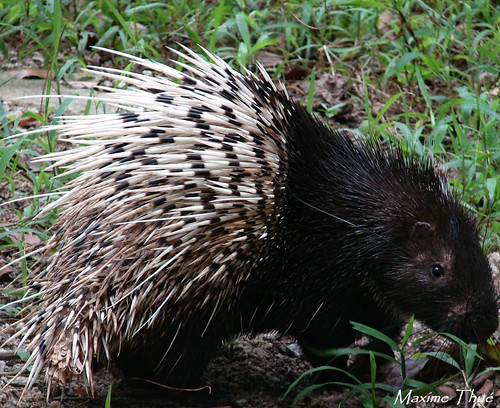
(Photo by Maxime Thué)
The Malayan porcupine has a very wide distribution, ranging from Nepal and northeast India to central and southern China, Myanmar, and Indochina, all the way south through Thailand and Peninsular Malaysia, as well as on the islands of Sumatra and Borneo. It is primarily an inhabitant of forests, but will also live in open areas nearby, and will enter agricultural land. The species is currently listed as being of Least Concern, although populations are generally thought to be decreasing as a result of habitat destruction and hunting for food.
Camera traps have captured images of Malayan porcupines at several locations in Asia:
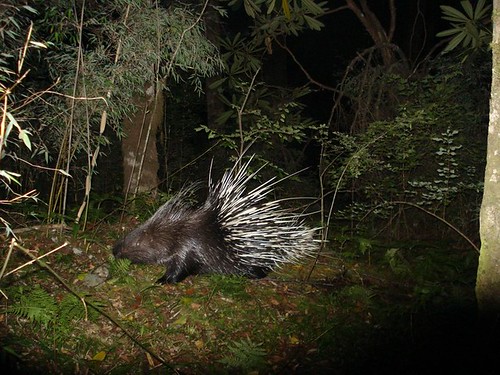
In Wolong National Nature Reserve in Sichuan province, China;
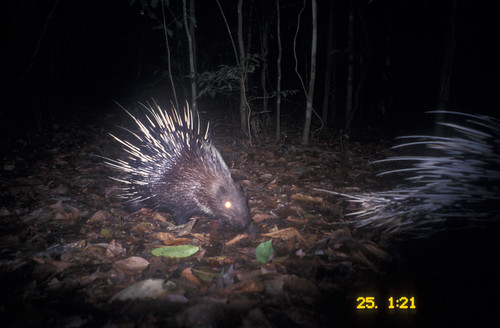
In Khao Yai National Park in Thailand;
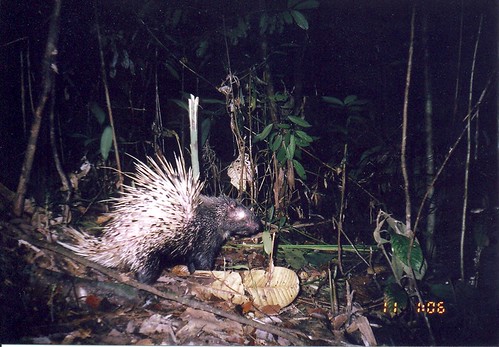
And in Sarawak, East Malaysia;
(All photos from Smithsonian Wild)
Old World vs. New World
The word porcupine comes from Middle French porc espin (spined pig). Porcupines do bear some vague resemblance to pigs, but are actually among the largest rodents. Contrary to popular belief, porcupines do not shoot their quills, which are highly modified hairs; rather, the quills are loosely embedded in the skin, and may simply be dislodged upon contact with the soft flesh of a predator.
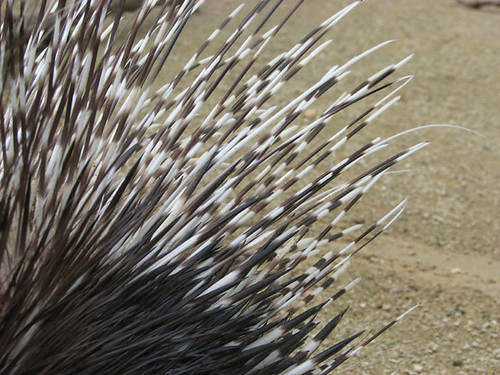
(Photo by LongNeks)
There are actually 2 different families of rodents known as porcupines. The Old World porcupines (F. Hystricidae) comprise 11 species found throughout the warmer parts of Africa, Asia, and southern Europe. The 17 or so species of New World porcupines (F. Erethizontidae), on the other hand, are predominantly found in the forests of tropical South and Central America, with one species found in temperate North America. Although both the Old World and New World porcupines belong to the same branch of the rodent family tree (Hystricognathi), they are actually not closely related to one another; the New World porcupines' closest kin encompass various other South American rodent families such as cavies (F. Caviidae), chinchilla (F. Chinchillidae), and agoutis (F. Dasyproctidae), collectively known as the Caviomorpha, whereas the Old World porcupines appear to stem from more ancient stock, and are believed to be basal to the split between the caviomorphs and the other major branch of the Hystricognathi, the Phiomorpha. In other words, despite both families possessing quills as a form of defence against predators, this is actually a result of convergent evolution.
The New World porcupines look very different from their Old World counterparts.
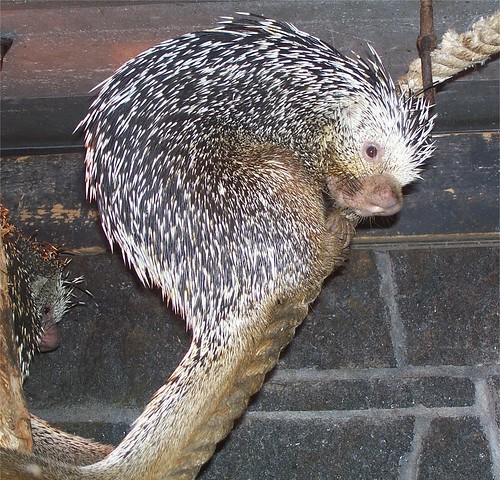
Brazilian porcupine (Coendou prehensilis);
(Photo by lophura)
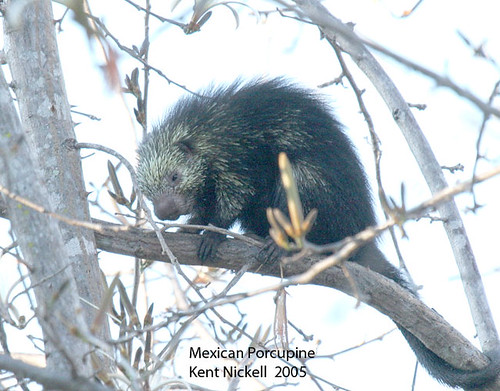
Mexican Hairy Dwarf Porcupine (Sphiggurus mexicanus);
(Photo by mountainpath2001)

North American porcupine (Erethizon dorsatum);
(Photo by Critter Seeker)
Unlike Old World porcupines, New World porcupines are highly arboreal, and many species spend much of their time in the trees. To aid in climbing, many species also possess a relatively long, prehensile tail. Old World porcupines are entirely terrestrial, and excavate an elaborate system of burrows and tunnels. Old World porcupines are also considerably more sociable than New World porcupines, living in small family groups consisting of a mated pair and their young, with juveniles from previous litters staying behind even after reaching maturity.
Porcupines are herbivores, feeding on bark, roots, tubers, bulbs, and fallen fruit, although they will also occasionally nibble on carrion and insects. They are also fond of gnawing on old bones for calcium and to sharpen their incisors, and are known to amass large collections of bones and other hard objects in their lairs. Such behaviour has led to some confusion in the past, when paleontologists studied fossilised accumulations of bones in African caves, and upon finding bones with scratches and gouges and others that had been sharpened, proposed that these were signs of ancient hominids. According to such hypotheses, australopithecines once lived in these caves, made tools and weapons out of animal bones, and used them to butcher the carcasses of prey. Clearly, the piles of bones represented the remains of animals killed and then taken apart by bone tools. In the end, it was discovered that many of these sites were actually made by porcupines, and that any scratching and sharpening of bones had been carried out by rodent incisors, not hominid hands.

Skull of Malayan porcupine. Those certainly are some very impressive incisors for gnawing;
(Photo from Skulls Unlimited)
Hystricids
Besides the Malayan porcupine, there are 10 other species of Old World porcupine.

The Sunda porcupine (Hystrix javanica) is closely related to the Malayan porcupine, and is found on Java and other nearby islands such as Bali, Sumbawa, Flores, Lombok, and Madura;
(Photo by Montybruce)
8 Old World porcupine species are classified under the genus Hystrix, which itself has 3 subgenera; both the Malayan and Sunda porcupines belong to the subgenus Acanthion, whereas 3 species belonging to the subgenus Thecurus are found on various islands in tropical Southeast Asia.

The Philippine porcupine (Hystrix pumila), pictured here, is endemic to Palawan and neighbouring islands in the Philippines. It is sometimes known to locals as "durian", due to the resemblance to the thorny fruit. The other 2 members of the subgenus Thecurus are the Sumatran porcupine (Hystrix sumatrae) of Sumatra, and the thick-spined porcupine (Hystrix crassispinis) of Borneo;
(Photo by Roslyn in Starfish Island)

Thick-spined porcupine, Sarawak;
(Photo from Smithsonian Wild)
The 3 members of the subgenus Hystrix itself are notable for the crest of long hairs on the head.

The crested porcupine (Hystrix cristata) can be found in northern and eastern Africa and oddly enough, Sicily and southern Italy (its presence in southern Europe might be due to introduction by humans);
(Photo by Pat's Pics36)
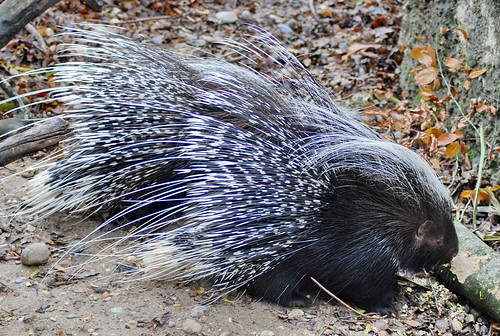
The Cape porcupine (Hystrix africaeaustralis) is native to eastern and southern Africa (its distribution overlaps that of the crested porcupine in Tanzania, Kenya and Uganda);
(Photo by ritsch48)

The final species, the Indian porcupine (Hystrix indica), is distributed from Turkey and the Arabian Peninsula, through Iran, Afghanistan, and Pakistan, to India and Sri Lanka;
(Photo by pamelainob)
Besides Hystrix, there are 2 species of Atherurus, the brush-tailed porcupines, which look a lot like large rats, albeit with quills on their hindquarters and tail.
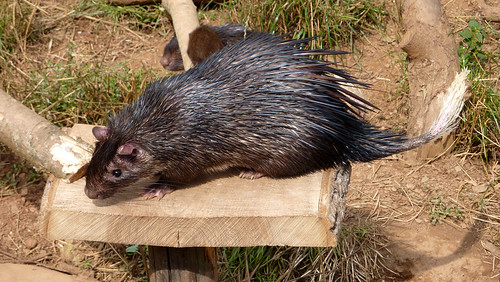
African brush-tailed porcupine (Atherurus africanus) inhabits forests of western and central Africa, from Sierra Leone in the west to Kenya in the east;
(Photo by Glamhag)
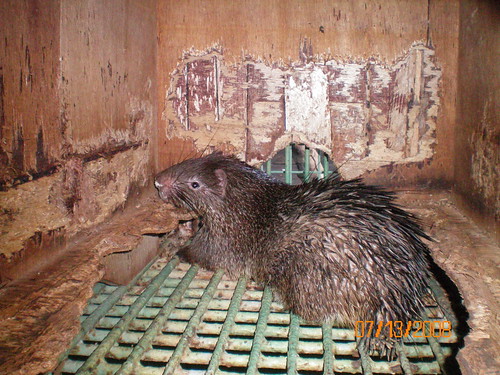
The Asiatic brush-tailed porcupine (Atherurus macrourus) has a distribution similar to that of the Malayan porcupine, being found from northeastern India to southern and central China, through Indochina and Thailand to Peninsular Malaysia;
(Photo by mjboloy_25)

The final species of Old World porcupine, the long-tailed porcupine (Trichys fasciculata) of the Malay Peninsula, Sumatra, and Borneo, looks even more like a large, bristly rat;
(Photo by Jonas Livet)

Although the long-tailed porcupine has a much sparser covering of quills compared to other porcupine species, it does have one trick up its sleeve; if grabbed, the tail breaks off easily, allowing the porcupine to escape. However, unlike in lizards, the tail of the long-tailed porcupine does not regrow once it has been shed;
(Drawing by Michigan Science Art)
Porcupine Predators
The quills certainly serve as a very effective deterrent against predators such as leopards (Panthera pardus) and tigers (Panthera tigris); when faced with a threat, porcupines raise their quills to look larger and more intimidating, and stamp their feet. Some of the quills on the tail are shorter and have hollow tips, and by shaking them, the porcupine creates a loud hissing rattle. Finally, if intimidation fails, the porcupine charges backwards into its target, impaling it with the long, sharp quills. In unlucky cases, the quills may puncture the internal organs of the attacker, killing it.


(Photos by Shem Compion)
In most cases, the predator flees with puncture wounds in its face, mouth, or paws. The quills can be difficult to remove intact, and attempts to pull them out often result in the quill snapping, with the tip still embedded in the skin.
"Kenneth Anderson, who hunted dangerous wildlife in southern India in the mid-twentieth century, reported finding a dead tigress, emaciated and pierced by twenty-three quills. One quill had destroyed her right eye."Injuries from porcupine quills may lead to infection, causing the predator to become incapacitated and crippled. Unable to hunt its usual prey, the predator may ultimately starve, or even become a man-eater.
- Gordon Grice, Deadly Kingdom
"I quote the case of the Muktesar man-eating tigress. This tigress, a comparatively young animal, in an encounter with a porcupine lost an eye and got some fifty quills, varying in length from one to nine inches, embedded in the arm and under the pad of her right foreleg. Several of these quills after striking a bone had doubled back in the form of a U, the point, and the broken-off end, being quite close together. Suppurating sores formed where she endeavoured to extract the quills with her teeth, and while she was lying up in a thick patch of grass, starving and licking her wounds, a woman selected this particular patch of grass to cut as fodder for her cattle. At first the tigress took no notice, but when the woman had cut the grass
right up to where she was lying the tigress struck once, the blow crushing in the woman's skull. Death was instantaneous, for,
when found the following day, she was grasping her sickle with one hand and holding a tuft of grass, which she was about to
cut when struck, with the other. Leaving the woman lying where she had fallen, the tigress limped off for a distance of over
a mile and took refuge in a little hollow under a fallen tree. Two days later a man came to chip firewood off this fallen tree,
and the tigress who was lying on the far side killed him."
...
"I myself had not looked closely at the tiger, but at 2 p.m., when I laid him on his back to start the skinning, I noticed
that most of the hair from the inner side of his left foreleg was missing, and that there were a number of small punctures in
the skin, from which yellow fluid was exuding. I did not draw attention to these punctures, and left the skinning of the leg,
which was considerably thinner than the right leg, to the last. When the skin had been removed from the rest of the animal,
I made a long cut from the chest to the pad of the festering left leg, and as I removed the skin, drew out of the flesh,
one after another, porcupine quills which the men standing round eagerly seized as souvenirs; the longest of these quills
was about five inches, and their total number was between twenty-five and thirty. The flesh under the skin, from the
tiger's chest -to the pad of his foot, was soapy, and of a dark yellow colour; cause enough to have made the poor beast moan
when he walked, and quite sufficient reason for his having become and having remained a man-eater, for porcupine quills
do not dissolve no matter how long they are embedded in flesh.
I have extracted, possibly, a couple of hundred porcupine quills from the man-eating tigers I have shot. Many of these quills have been over nine inches in length and as thick as pencils. The majority were embedded in hard muscles, a few were wedged firmly between bones, and all were broken off short under the skin.
Unquestionably the tigers acquired the quills when killing porcupines for food, but the question arises to which I regret
I am unable to give any satisfactory answer why animals with the intelligence, and the agility, of tigers, should have been
so careless as to drive quills deep into themselves, or be so slow in their movements as to permit porcupines whose only method
of defending themselves is by walking backwards to do so; and further, why the quills should have been broken off short, for porcupine quills are not brittle.
Leopards are just as partial to porcupines as our hill tigers are, but they do not get quills stuck in them, for they kill
porcupines as I have seen by catching them by the head; and why tigers do not employ the same safe and obvious method of killing as leopards employ, and so avoid injury to themselves is a mystery to me."
- Jim Corbett, Man-Eaters of Kumaon

(Photo by ericlawrence)
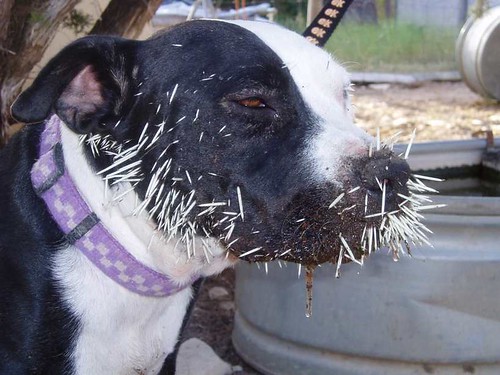
(Photo by Adventures With Boris)
However, porcupines are not completely invulnerable, and do fall prey to large predators such as big cats and hyenas. The best way to dispatch a porcupine is to dodge the quills and aim for the unprotected face. In the meantime, the porcupine is aware that its face is exposed and vulnerable, and hence will keep wheeling around, presenting its spiny posterior to the threat.
While a juvenile leopard or tiger might investigate and toy with a porcupine due to inexperience and not being aware of the danger, it is likely that some of these subsequently manage to improve their hunting skills, learn how to deal with such challenging prey, and make a habit out of killing porcupines. I suppose the amount of flesh on a porcupine is worth the risk of getting impaled by quills.
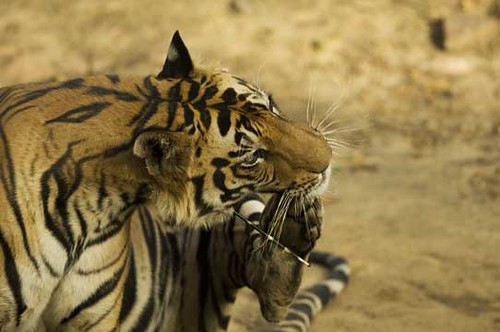
Juvenile tiger that had a habit of hunting porcupines;
(Photo by satyendrak)

Leopard with porcupine kill;
(Photo by Gary Parker Photos)
However, humans today are among the most significant predators of porcupines; porcupine is featured heavily in bushmeat, and carcasses can be found in markets throughout much of Africa and Asia. While all porcupine species are considered to be of Least Concern (only the Philippine porcupine is listed as Vulnerable), populations of some species are thought to be decreasing due to habitat destruction and hunting pressure.
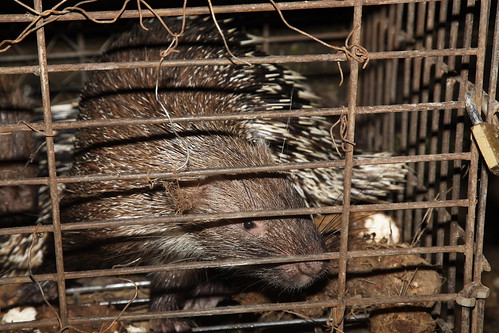
Sunda porcupine, Java;
(Photo by Rowan Castle)
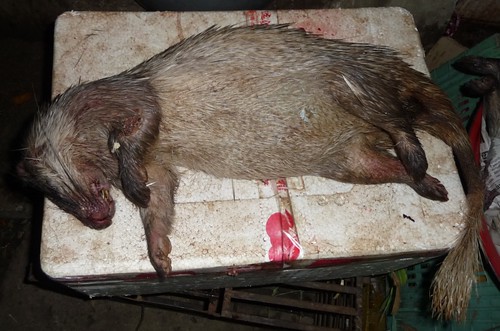
Asiatic brush-tailed porcupine, Laos;
(Photo by algodong)
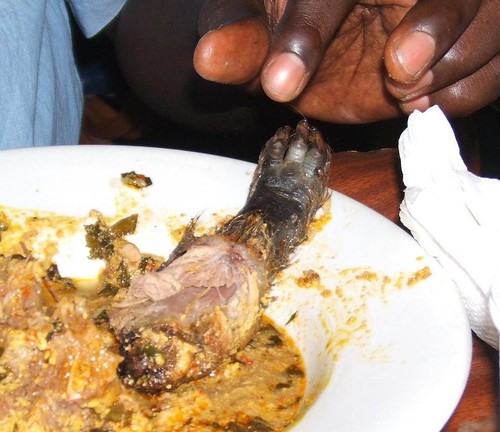
A Nigerian dish prepared with porcupine meat;
(Photo by sendroiu)

Porcupine quills are often seen for sale in African markets, due to their use in traditional remedies and black magic;
(Photo by RobertCoxwell)
Porcupine Romance
No discussion about porcupines is complete without the inevitable question: How do they mate without hurting each other with their quills?
Of course, the answer is, "Very carefully." If the female is receptive to the male's advances, she relaxes, flattens her quills, and raises her tail. Copulation itself is quite standard.
Interestingly, this video, recorded in South Sumatra, appears to depict 2 albino individuals of the Malayan porcupine.
Baby porcupines are covered in soft, flexible quills, preventing them from injuring the mother when they are born. The quills subsequently harden a few hours after birth. Unlike other rodents, porcupines have small litters, giving birth to one or two young at a time. By the way, a baby porcupine is called a porcupette.
I had no idea porcupettes could be so ridiculously cute. Makes you want to pick one up and give it a hug, quills and all.





(Photos from ZooBorns)
There is something comical yet menacing about porcupines. Perhaps it's the fact that these rodents are well-armed, and know how to use their weapons against threats, including careless humans. So far, porcupines in other countries seem to be resilient in the face of deforestation and hunting, and have managed to adapt to living in disturbed habitats close to humans. Hopefully, with better protection and restoration of Singapore's forests, we may be able to see the comeback of these admittedly endearing critters. I just hope that if I ever encounter a porcupine in the wild, I'll be a safe distance away from its rear end.